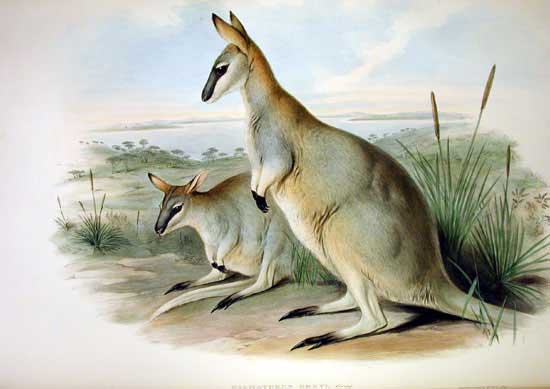
The Toolache wallaby or Grey’s wallaby (Macropus greyi) is an extinct species of wallaby from southeastern South Australia and southwestern Victoria.
The Toolache wallaby was a slim, graceful, and elegant creature that had a pale ashy-brown pelt with a buff-yellow underbelly. The tail was pale grey and became almost white near the tip. The distinct black mark on its face reached from its nose to the eye. The forearms, feet, and tips of the ears were also black. The different colors of the animal also consisted of different textured furs which are believed to have changed seasonally or varied depending on the individual. The body measurements differed between males and females. In general, male Toolache wallabies had a head and body length up to 810 mm while females measured up as 840 mm. Despite the females being taller, males had longer tail lengths at about 730 mm while the female’s tail length was 710 mm.
The Toolache wallaby occupied the south-eastern corner of Australia to the western part of Victoria. The preferred habitat ranged from swampy short grassland areas, to taller grassed areas of the open country. Toolache wallabies were known to be sociable creatures who lived in groups; they were often seen resting and grazing in groups.
The Toolache wallaby only survived 85 years after European occupation. In the 1920s, a conservation effort was made to try and bring the animal back from the brink of extinction. The plan was to capture and breed the last known surviving members of the species in captivity. This effort ended in disaster after 10 of the 14 of them were accidentally killed in the attempt to capture them. The remaining four survived in captivity.
The last wild sightings were recorded in 1924, and the last known Toolache wallaby survived in captivity until 1939. The species is presumed to be extinct although extensive research is still being conducted in the region after reports of suspected sightings through the 1970s. However, no members of the species have been sighted since.